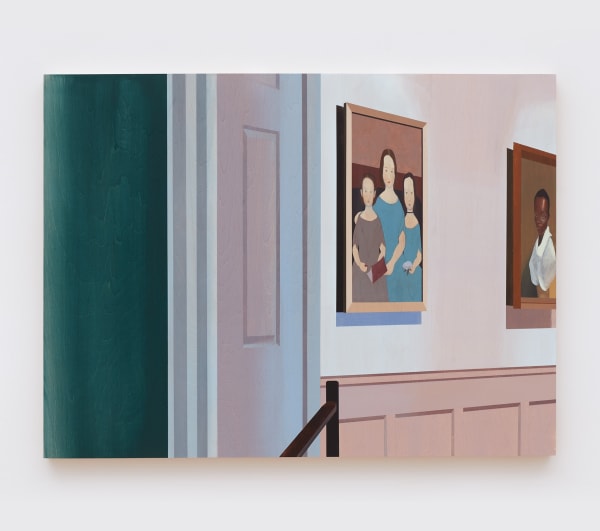-
Works
-
 Emily PettigrewBack From the Mainland, 2024Acrylic on wood panel36 x 48 in (91.4 x 121.9 cm)
Emily PettigrewBack From the Mainland, 2024Acrylic on wood panel36 x 48 in (91.4 x 121.9 cm) -
 Emily PettigrewDarken my Doorstep, 2024Acrylic and graphite on wood panel30 x 40 in (76.2 x 101.6 cm)
Emily PettigrewDarken my Doorstep, 2024Acrylic and graphite on wood panel30 x 40 in (76.2 x 101.6 cm) -
 Emily PettigrewFour Girls in the Hall, 2024Acrylic and graphite on wood panel30 x 40 in (76.2 x 101.6 cm)
Emily PettigrewFour Girls in the Hall, 2024Acrylic and graphite on wood panel30 x 40 in (76.2 x 101.6 cm) -
 Emily PettigrewShaker's Cat, 2024Acrylic on wood panel25 x 35 in (63.5 x 88.9 cm)
Emily PettigrewShaker's Cat, 2024Acrylic on wood panel25 x 35 in (63.5 x 88.9 cm) -
 Emily PettigrewThe Funeral, 2024Acrylic and graphite on wood panel18 x 24 in (45.7 x 61 cm)
Emily PettigrewThe Funeral, 2024Acrylic and graphite on wood panel18 x 24 in (45.7 x 61 cm)
-
-
Text
Today, the words sensible and sensitive are oddly almost opposite in meaning.To be sensible is to be reasonable, objective, unswayed by the wind.To be sensitive is to be emotional, subjective, set off by a breeze.
So it’s rather surprising to find that these sororal twins were once identical. A couple hundred years ago, they both meant having an acute receptiveness to sensory input—a sense that today usually applies to things like a microphone or light meter. Back in the day, being sensible or sensitive set you apart as special—just remember how only a true princess was sensible (or sensitive) enough to feel a pea beneath all those mattresses.
As that suggests, being sensible also implied you could sense things that others could not— even invisible things like a change in the mood, a charge in the air or even the gossamer boundary between the noon-bright world we see and the darkling world we don’t.
These days, with most artists preferring to be seen as embodying academic rather than sensory superiority, the idea of sensibility has fallen into disrepair. Or at least into silence. But they are out there.The painter Emily Pettigrew, for one, has a sensibility in spades. Having grown up in rural, coastal Maine with a fondness for the historic lore of fairies, Pettigrew is still drawn to the idea of “places where the veil is thin,” or the growing block universe, where past and present exist as one.
But while the fairy-tale aesthetic has certainly woven is glimmering spell over any number of painters in the last decade, Pettigrew has focused more on the adult’s world than the child’s, searching for disquieting moments that function like passkeys that open not only into different centuries of New England history but to various chapters of art history as well.There are windows that look into everything from the late-18th century American primitive to the oeuvres of Grant Wood, Edward Hopper, Alex Katz, Lois Dodd, Elizabeth Peyton and maybe even Wednesday Adams.
Such a wide scope can be daunting. Pettigrew keeps her own sensibility in sight by focusing on moments that she experiences herself, in person, and where she can feel something beyond what her eye (or iPhone) saw—a sense of something a little spooky, uncanny or off. That something can be inherent in the set-up, like awkward figures interacting at a funeral; or it can be almost generic, like a black cat in a sunlit window. Or it can be almost so unremarkable that what is uncanny goes unnoticed, as with her shadow creaking into the doorway of an historic Shaker house. You have to be fully present to see it, otherwise like all shadows it flits past as is gone.
Or the unease can lie in how things are framed, literally and figuratively, as with the case of a painting of a slanted view of two historic paintings in a museum, seen through a doorway. One is an Early American primitive painting of three white girls; the other is a 19th- century portrait of a Black girl.The collapsing awkwardness of the three times and their views —present, past, and further past—feels ordinary at first, but it gets under the skin and becomes subtly unnerving. What time is it, now?
“I love the mystery of things like this, of being able to sense different moments in time,” says Pettigrew, who lives in an historic house in the Catskills. “I am very into folklore and folk customs. I love strange little things and houses, like a weirdly shaped little salt box. I have a stairway in my house that’s like a secret compartment.”
She even has spooky, early American bangs.
It would be easy to glance at Pettigrew’s paintings and mistake her for a traditionalist. But what makes her work so interesting is that she does not try to reject or deny the darkness of American history. Rather, by incorporating the edge of darkness in her depictions of sunlit white clapboard siding, Pettigrew manages to create a startlingly contemporary point of view that depicts and accepts the past not just for what it was, but for what it is.
David Colman
-
Q&A

-
Installation Views









